
If you want better indoor air quality, you need a quality air purifier. Air purifiers reduce the airborne allergens that aggravate allergies and asthma. Air purifiers made by Austin Air, Blueair, Aeris Health, and AllerAir are effective weapons against contaminated air. As dirty, contaminated air flows through the air purifier, fresh, clean air flows into your home. The types of air filters in an air purifier determines how the air purifier works and how well it works. So what is the best air filter for your needs?
HEPA Filters:
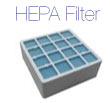 HEPA air filters set the standard for air cleaners today. In the 1940s, the U.S. Atomic Energy Commission developed HEPA (High Energy Particulate Air) filters in an attempt to filter radioactive contaminants. To be classified as a HEPA filter, it must capture a minimum of 99.97% of pollutants at 0.3 microns.
HEPA air filters set the standard for air cleaners today. In the 1940s, the U.S. Atomic Energy Commission developed HEPA (High Energy Particulate Air) filters in an attempt to filter radioactive contaminants. To be classified as a HEPA filter, it must capture a minimum of 99.97% of pollutants at 0.3 microns.
HEPA filtration captures particles 25-50 times smaller than the eye can see. The ultra-fine fibers in HEPA filters capture microscopic particles through a combination of diffusion, interception, and inertial impaction. With smaller particles, diffusion occurs when the random motion of the particles causes them to collide with fibers. Interception occurs when larger particles directly collide with a fiber. When a particles inertia leads to its collision with a fiber, this is known as inertial impaction.
HEGA Filters:
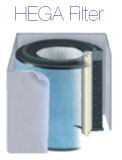 |
You might have also heard of HEGA or High Efficiency Gas Adsorber filters. Specific to Austin Air, HEGA filters must exhibit a minimum efficiency of 99.9%, per standards of the Institute of Environmental Sciences, and use “adsorber” filtration to filter out chemicals, gases, and odors.Adsorber filtration combines carbon or carbon/zeolite pellets into a carbon-cloth filter to trap gaseous particles. Specific to the HEGA filter, the adsorber filtration method must be designed, built, filled and packaged to adhere to these specific standards. The HEGA air filter must also remove irritants such as dust, pollen, mold spores, bacteria, and pet dander to be considered a HEGA filter. |
The Austin Air Healthmate air purifier series includes a unit with HEGA filtration. Austin Air discovered and developed the new HEGA technology, which involves weaving carbon into a lightweight cloth. The Austin Air Allergy Machine is the ideal air purifier for someone who wishes to remove gases, vapors, and odors as well as allergens and other particulate matter.
Activated Carbon Filters:
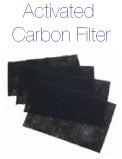 Activated Carbon Filters remove gases, odors, and chemical toxins. Carbon, or activated charcoal, is treated with oxygen to open up the millions of tiny pores between the carbon atoms.
Activated Carbon Filters remove gases, odors, and chemical toxins. Carbon, or activated charcoal, is treated with oxygen to open up the millions of tiny pores between the carbon atoms.
The activated charcoal adsorbs odorous substances from gases or liquids. The term “adsorbing” refers to the way the pollutants attach to the charcoal by chemical attraction. The large surface area of the activated charcoal gives it thousands of pores for trapping pollutants. As chemicals and pollutants pass the carbon surface, they are immediately attracted and captured within the filter.
Some carbon filters are treated with additional chemicals like potassium iodide or potassium permanganate which improve the carbon filters ability to capture Volatile Organic Compounds (VOCs) and other chemically reactive gases. Activated carbon filters adsorb a wider spectrum of contaminants.
AllerAir air purifiers use an activated carbon filtration system to effectively clean indoor air. AllerAir models feature a cylindrical shape for maximum air flow, an effective four-stage filtration system, and a quiet fan. AllerAir air purifiers are designed to remove pet dander, pollen, dust, mold spores, chemical vapors, odors, and VOCs.
Electrostatic Filters:
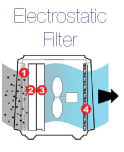 Like Activated Carbon filters, Electrostatic filters attract pollutants. Instead of carbon, Electrostatic filters use electrostatic charges to clean the air. Electrostatic charges are created by pushing air through a maze of static prone fibers. As airborne particles move past the static prone fibers, they become attracted to the static charge and are captured within the filter. The particles remain on collector plates until they are hand washed or removed by a HEPA vacuum cleaner.
Like Activated Carbon filters, Electrostatic filters attract pollutants. Instead of carbon, Electrostatic filters use electrostatic charges to clean the air. Electrostatic charges are created by pushing air through a maze of static prone fibers. As airborne particles move past the static prone fibers, they become attracted to the static charge and are captured within the filter. The particles remain on collector plates until they are hand washed or removed by a HEPA vacuum cleaner.
By using static electricity, you never have to worry about replacing the filters, as most electrostatic air cleaners use collection plates to capture pollutants and can be cleaned easily. However, the collection plates must be cleaned frequently to ensure effective air cleaning. Also, unlike HEPA filters, some electrostatic filters emit ozone, a dangerous lung irritant that can trigger asthma and allergy symptoms, as well as other respiratory issues.
Air Filtration Systems:
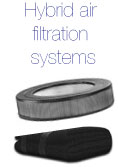 The Hybrid air filtration system maximizes its effectiveness through the use of multiple technologies. Hybrid filters use a combination of filtration methods, each filter adding to the overall effective quality of the air purifier.
The Hybrid air filtration system maximizes its effectiveness through the use of multiple technologies. Hybrid filters use a combination of filtration methods, each filter adding to the overall effective quality of the air purifier.
Most effective air purifiers a use combinations of the filters listed above.Honeywell air purifiers combine True HEPA filtration and an activated carbon pre-filter to maximize efficiency. Honeywell air purifiers also feature a patented 360-degree air intake/discharge system for maximum performance and reduction of airborne particles, allergens, gaseous contaminates, and VOCs.
Charged Media Filters:
 Charged media filters also utilize electrostatic energy. Made from synthetic fibers, the media filter is charged through the manufacturing process and retains the charge during its use. This charge attracts airborne particles, giving them an electrostatic charge before trapping them within the fibers of a conventional filter.
Charged media filters also utilize electrostatic energy. Made from synthetic fibers, the media filter is charged through the manufacturing process and retains the charge during its use. This charge attracts airborne particles, giving them an electrostatic charge before trapping them within the fibers of a conventional filter.
Charged media filters present relatively low energy costs and are extremely efficient. However, as the filter becomes soiled, it becomes resistant to the airflow, making it less efficient the more soiled it becomes. Therefore, charged media filters must be changed regularly for peak performance.
Charged media air cleaners are known for their energy-efficiency and quietness; however, some of them may emit ozone. Blueair air purifiers utilize the best charged media filtration, dont emit ozone, and are extremely quiet and efficient.
NQ Clarifier air purifiers also feature a charged media filter within their five stage filtration process, allowing them to absorb a wider spectrum of allergens, gases, viruses and bacteria than any other air cleaner. The NQ Clarifier includes polyester pre-filters which absorb dust and pet dander, and a carbon media drum to capture gases and chemicals. A true HEPA cloth is also included to filter pollen, mold spores, and other allergens and particles, while a UV lamp filter sanitizes bacteria and viruses as they pass through the filtration systems. Lastly, a carbon post-filter removes any excess contaminants, ensuring that no particle can escape the filtration system of the NQ Clarifier air purifier. This unique five-stage filtration process allows the NQ Clarifier air purifier to provide hospital-grade filtration efficiency in the comfort of your own home.
The combination of air filtration systems is the next revolutionary step to cleaner indoor air quality. However, each filter type presents its own unique sphere of air cleaning. Its important to determine what your air cleaning needs are and to research and find the filter that will work best for you and your needs.
